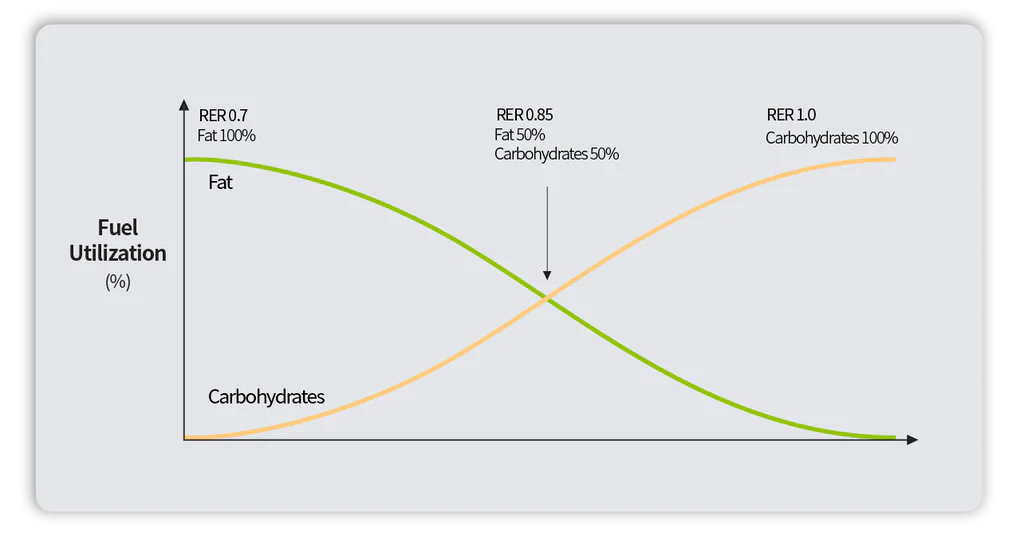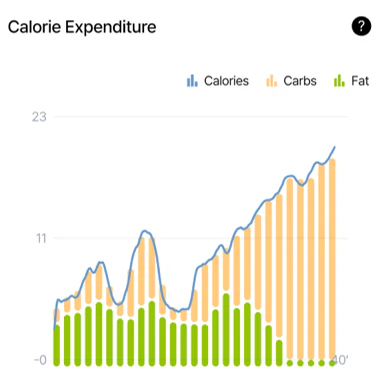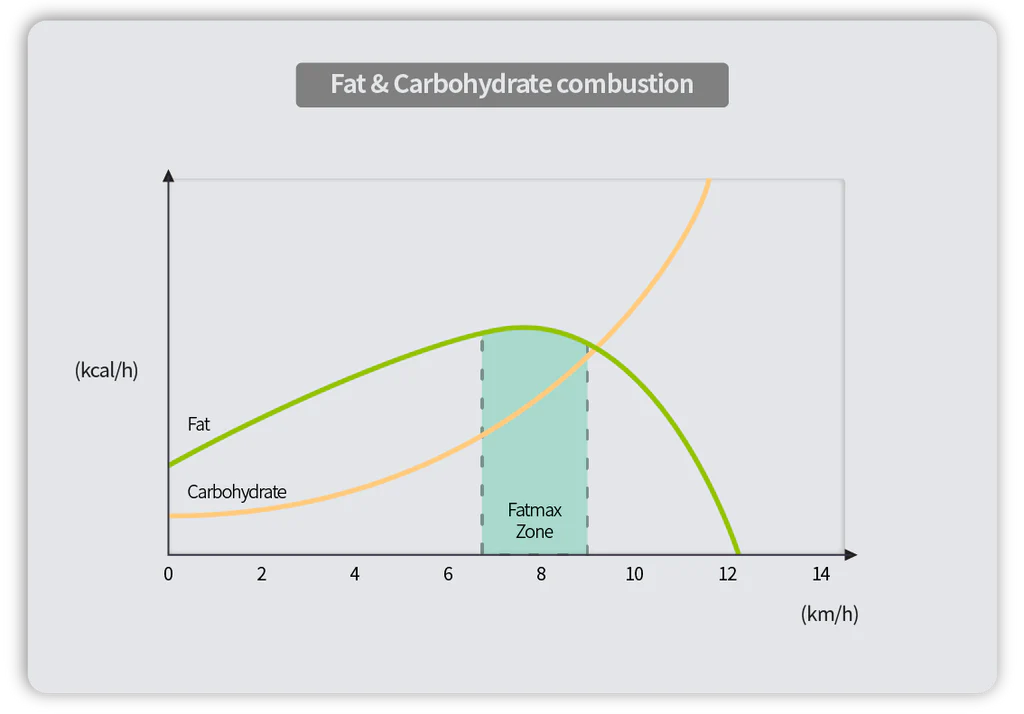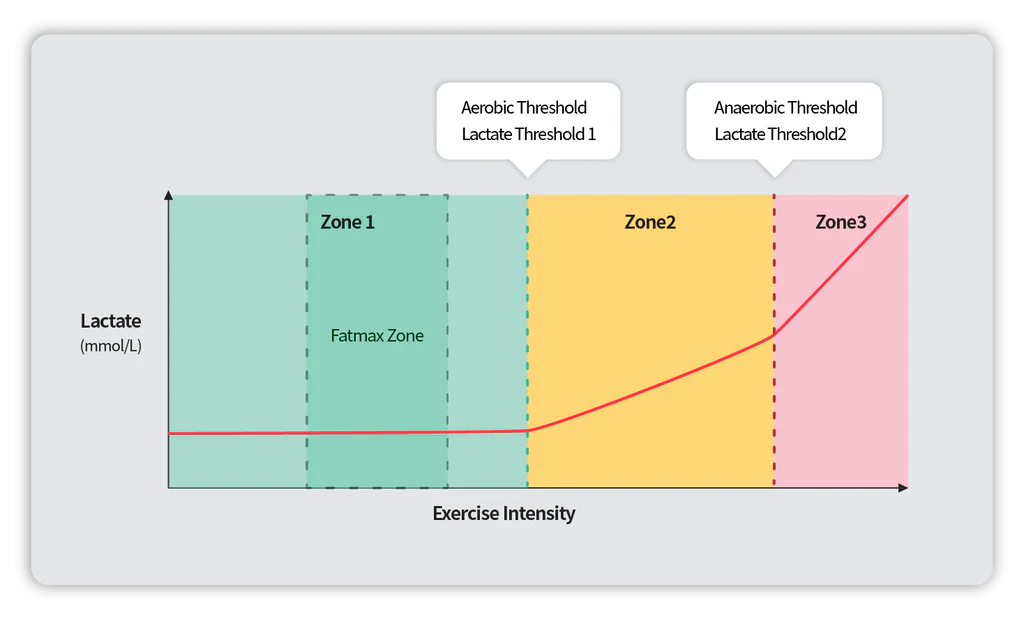
Respiratory Exchange Ratio (RER) and FatMax
Introduction
As we enter 2025, many people set New Year's resolutions, often revolving around three common goals: quitting alcohol, quitting smoking, and losing weight. Every year, countless individuals sign up for gym memberships and start exercising with renewed determination. They push themselves hard, endure heavy breathing, and suppress their hunger in pursuit of their goals. However, when they step onto a body fat analyzer, they often find little change in body fat percentage. Frustration sets in, and their resolutions begin to falter—leading to the same cycle repeating year after year. Many individuals engage in exercise primarily for fat loss. However, despite their effort, they frequently find themselves feeling only hungry, with minimal reduction in body fat. This phenomenon can be explained through the concept of the respiratory exchange ratio (RER) and its role in substrate utilization.

Understanding the Respiratory Exchange Ratio (RER)
The Respiratory Exchange Ratio (RER) is the ratio of carbon dioxide (VCO2) produced to oxygen (VO2) consumed during respiration (RER = VCO2/VO2). Typically, RER values range between 0.7 and 1.0, with an average resting RER of approximately 0.8. However, variations occur due to physiological and psychological factors, and during intense exercise, RER can exceed 1.0 due to increased reliance on anaerobic metabolism. RER serves as an indirect measure of substrate oxidation, indicating whether the body primarily utilizes carbohydrates or fats for energy. The metabolic processes of glucose and fatty acid oxidation yield different RER values, as illustrated by the following equations:
- Glucose: C₆H₁₂O₆ + 6O₂ → 6CO₂ + 6H₂O (RER = 1.0)
- Fatty Acid (Palmitic Acid): C₁₆H₃₂O₂ + 23O₂ → 16CO₂ + 16H₂O (RER = 0.70)
For glucose oxidation, six oxygen molecules are consumed to produce six carbon dioxide molecules, resulting in an RER of 1.0. In contrast, fatty acid oxidation requires a greater oxygen intake relative to carbon dioxide production, leading to an RER of approximately 0.7. When fat is the primary energy source, RER approaches 0.7, while exclusive carbohydrate metabolism yields an RER of 1.0. Thus, by monitoring RER, one can estimate the proportion of fat and carbohydrate utilization during different states of activity. Palmitic acid, used in the above equation, is one of the most prevalent saturated fatty acids found in biological systems.

Exercise Intensity and FatMax
As exercise intensity increases, respiratory demand rises, leading to higher carbon dioxide production and an elevated RER. This shift corresponds to an increased reliance on carbohydrates for energy. Conversely, at lower exercise intensities, oxygen availability remains sufficient, RER remains lower, and fat oxidation predominates. The graph below illustrates this relationship:
- High-intensity exercise results in greater total energy expenditure but relies primarily on carbohydrate metabolism.
- Low-to-moderate intensity exercise supports higher fat oxidation rates, despite lower overall caloric expenditure.

The exercise intensity at which fat oxidation reaches its peak is termed FatMax. To maximize fat utilization, individuals should train at intensities where FatMax occurs—typically within a moderate aerobic zone rather than high-intensity training.

FatMax and LT1
The most accurate way to determine an individual’s FatMax intensity is through respiratory gas analysis to measure RER directly. However, since such assessments are not always feasible, an alternative approach is to approximate FatMax using established metabolic thresholds. One such threshold is LT1 (First Lactate Threshold), which marks the transition from predominantly aerobic metabolism to a slight increase in blood lactate accumulation. At intensities below LT1, oxygen availability remains sufficient, aerobic metabolic efficiency improves, and RER remains low, indicating greater fat oxidation. Studies suggest that FatMax occurs at an intensity slightly below LT1, where total energy expenditure is moderate but fat oxidation is optimized. In contrast, exercising at or above LT1 increases carbohydrate reliance due to higher glycolytic activity.

In practical terms, FatMax training aligns with low-intensity aerobic exercise within Zone 1 and Zone 2, such as long slow distance (LSD) running, brisk walking, or light jogging.
Conclusion
While RER is a key factor in fat oxidation, substrate utilization is also influenced by variables such as biological sex, dietary habits, training status, and genetic predisposition. Nevertheless, one fundamental principle remains consistent: fat oxidation is maximized when exercise intensity is low enough to maintain steady breathing and aerobic metabolism. It is also important to recognize that exercise alone does not significantly compensate for excessive caloric intake. For example, the caloric content of an entire fried chicken is roughly equivalent to the energy expenditure of a full marathon. This highlights the importance of dietary control alongside exercise for effective weight management. However, while dietary restriction alone can lead to weight loss, it does not necessarily enhance metabolic health or cardiovascular fitness. Sustained physical activity is essential for long-term physiological benefits. Thus, exercise should be structured, sustainable, and enjoyable to ensure long-term adherence. Effective weight management does not come from extreme efforts but from consistent, well-paced activity that aligns with physiological principles. May this year’s resolutions bring lasting success.
References
- Achten, J., Gleeson, M., & Jeukendrup, A. E. (2002). Determination of the exercise intensity that elicits maximal fat oxidation. Medicine and Science in Sports and Exercise, 34(1), 92-97.
- Achten, J., & Jeukendrup, A. E. (2003). Maximal fat oxidation during exercise in trained men. International Journal of Sports Medicine, 24(08), 603-608.
- Achten, J., & Jeukendrup, A. E. (2003). The effect of pre-exercise carbohydrate feedings on the intensity that elicits maximal fat oxidation. Journal of Sports Science, 21(12), 1017-1025.
- Achten, J., & Jeukendrup, A. E. (2004). Relation between plasma lactate concentration and fat oxidation rates over a wide range of exercise intensities. International Journal of Sports Medicine, 25(01), 32-37.
- Bircher, S., & Knechtle, B. (2004). Relationship between fat oxidation and lactate threshold in athletes and obese women and men. Journal of Sports Science & Medicine, 3(3), 174.
- Carey, D. G. (2009). Quantifying differences in the “fat burning” zone and the aerobic zone: implications for training. The Journal of Strength & Conditioning Research, 23(7), 2090-2095.
- Goodpaster, B. H., Katsiaras, A., & Kelley, D. E. (2003). Enhanced fat oxidation through physical activity is associated with improvements in insulin sensitivity in obesity. Diabetes, 52(9), 2191-2197.
- Jeukendrup, A. E., & Wallis, G. A. (2005). Measurement of substrate oxidation during exercise by means of gas exchange measurements. International Journal of Sports Medicine, 26(S 1), S28-S37.
- Stisen, A. B., Stougaard, O., Langfort, J., Helge, J. W., Sahlin, K., & Madsen, K. (2006). Maximal fat oxidation rates in endurance trained and untrained women. European Journal of Applied Physiology, 98, 497-506.
- Van Aggel-Leijssen, D. P., Saris, W. H., Wagenmakers, A. J., Senden, J. M., & Van Baak, M. A. (2002). Effect of exercise training at different intensities on fat metabolism of obese men. Journal of Applied Physiology.
- Van Loon, L. J., Greenhaff, P. L., Constantin‐Teodosiu, D., Saris, W. H., & Wagenmakers, A. J. (2001). The effects of increasing exercise intensity on muscle fuel utilisation in humans. The Journal of Physiology, 536(1), 295-304.
- Venables, M. C., Achten, J., & Jeukendrup, A. E. (2005). Determinants of fat oxidation during exercise in healthy men and women: a cross-sectional study. Journal of Applied Physiology, 98(1), 160-167.